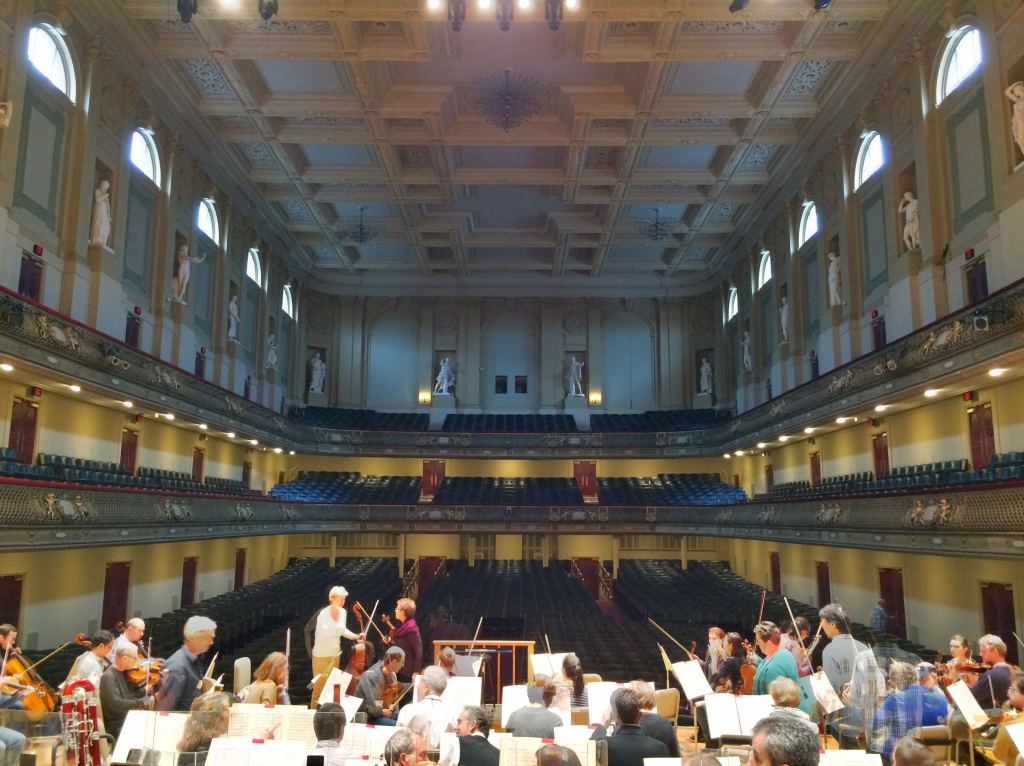
(By which I mean, of course, my age, not the age of the work.)
I last wrote about Brahms’ Ein deutsches Requiem in 2009, at the end of a run in which we performed the work in Symphony Hall, issued an official recording, and reprised it at Tanglewood. It was a different time: James Levine was at the relative height of his powers and I was singing more regularly with the Tanglewood Festival Chorus.
We reprised the work a few years later under Christoph von Dohnányi, in a totally different performance. By that time I wasn’t blogging as regularly so I don’t have any notes from that run. I remember a few things, though: his tempi were brisk, his interpretation totally unsentimental, and his demands on the chorus’s diction were fierce.
This run, which concluded a week ago, was to have been conducted by the great Rafael Frühbeck de Burgos, with whom I was fortunate to sing a few times. But he passed away this summer, and the task of filling his shoes went to Bramwell Tovey. The chorus had sung with him before, but I had not, and had heard about his affability but not much about his musicianship. He turns out to be, at least with the Requiem, a conductor concerned not so much with putting an individual stamp on the work than with seeking how the text determines the flow of the piece. To that end he, like Dohnányi, asked the highest level of diction and pitch precision from the chorus. Our chorus conductor, Bill Cutter, helped with that, pitilessly letting us know when we could be doing better.
For this performance, my third time through the work, I had a pretty good idea of what some of the major challenges would be for me. I wrote about some of them in the post from Tanglewood:
I found what may be the real culprit of the sixth movement, for me at least. It’s not just the overall arc of the piece, but specifically the tenor part immediately preceding the fugue, where all choral voices respond… And the text is sung at absolutely full volume over some of the thickest orchestration in the work, and in the high part of the tenor range.
This is the rub, at least for me. The need to support the voice is strong, but at that volume and emotional fervor it’s very easy to tip over from supporting to tightening, and then the battle is lost and the voice closes progressively until it is difficult to get any sound out at all. Once that happens the following fugue is unsingable.
Well, friends, I’m here to tell you that I had the right problem area, but the solution was both easier and harder than I thought.
The hard part was in placing my voice properly. I have never had more than a few hours of formal voice instruction since I got my full instrument, and so it takes me a while to learn things that I suppose most voice majors know inherently. (The hazards of being a sciences major and not taking advantage of the meager vocal instruction offerings at my undergrad, among other things.) Sometime over the past few years, though, I managed to learn about two important concepts in voice placement: singing toward and through the mask, and keeping the ceiling of the vocal chamber high. What follows is an embarrassing amateur’s assessment of how this works; I welcome correction.
The “mask,” or the frontal bones of the face, is where a good portion of the resonant overtones of the voice develop, due in no small part to vibrations through the sinus cavities (yes, they’re good for something besides infections). But the voice must be directed through this part rather than being allowed to linger in the back of the vocal chamber for the resonance to take effect. Once it does, the difference is startling: a brightness and sharpness to the sound that cuts through surrounding noise for far less vocal effort. The challenges are in keeping the sinuses clear (no small task thanks to the common cold) and managing the position of the facial muscles that support singing so that the placement happens properly.
The full vocal chamber, otherwise known as the front of the face, the cavity of the mouth, and the back of the throat, is important in developing the fullness of the sound. Again, my amateur guess is that this has something to do with developing the right resonant frequencies. It turns out that for me, one of the most important parts of this process, in addition to the mask, is keeping the soft palate, which forms the ceiling of the vocal chamber, high and out of the way. If it comes down, producing sound on pitch is much harder, the sound is muddied, and if you’re singing through the mask and not taking advantage of the full chamber you get a sharp thin sound rather than a penetrating fuller sound.
This leads me to the other thing that was much easier in solving the problem. One of the things that makes keeping the soft palate in the proper place extremely hard is not being prepared for the next vowel sound that is being produced. If you are unsure about whether an e or an ah is coming next, the palate doesn’t know where to go, and producing any sort of sound at all becomes a challenge of brute force.
In this context, my prior problem about my voice “tightening” had a simple diagnosis: I was not comfortable with the text. By that point in movement six my memory was generally unreliable so I couldn’t anchor the Den es wird die Pasaune schallen. I finally figured out what was going on in one of our rehearsals when we started on the second repetition, Der Tod is verschlungen in den Sieg, sung on virtually the same tune, and I had no difficulty in keeping the voice from tightening. Why? I knew the words better! I didn’t have to force the sound, and that meant I could keep the palate high and the muscles in the proper place! All I had to do to make this a general solution was focus on ensuring that I had the right words!
So for this run I managed, most of the time, to keep the apparatus such that I was producing the right sort of sound throughout, and it made all the difference in the world. I even sang in my church choir the following morning; usually after a Brahms Requiem run I’m a ragged baritone for at least a week.
Lessons learned?
- Stay conscious of the mask and the ceiling of the chamber.
- Learn the damned text. First, if possible.
This should be fun as we head into the Rachmaninoff that we’ll sing next. It’s been a long time since I’ve had to learn that much Russian.

